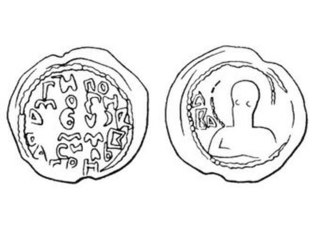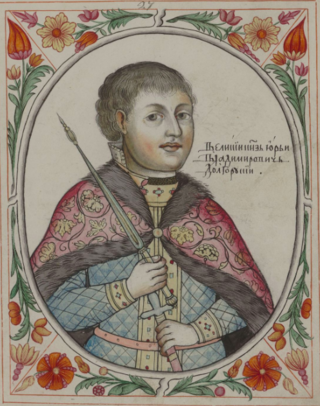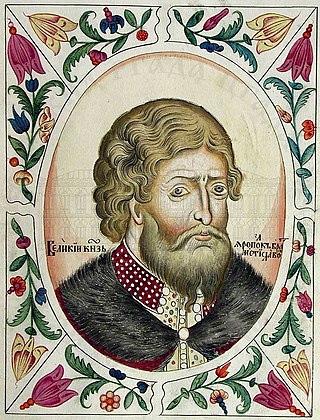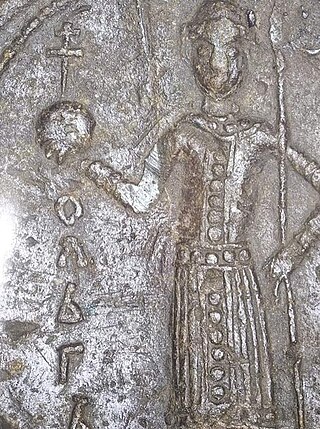
Year 1093 (MXCIII) was a common year starting on Saturday of the Julian calendar.

Vsevolod I Yaroslavich was Grand Prince of Kiev from 1078 until his death in 1093.

Vladimir II Monomakh was Grand Prince of Kiev from 1113 to 1125. He is considered a saint in the Eastern Orthodox Church and is celebrated on May 6.

Yuri I Vladimirovich, commonly known as Yuri Dolgorukiy or the Long Arm, was a Monomakhovichi prince of Rostov and Suzdal, acquiring the name Suzdalia during his reign. Noted for successfully curbing the privileges of the landowning boyar class in Rostov-Suzdal and his ambitious building programme, Yuri transformed this principality into the independent power that would evolve into early modern Muscovy. Yuri Dolgorukiy was the progenitor of the Yurievichi, a branch of the Monomakhovichi.

Iziaslav Yaroslavich was Prince of Turov and Grand Prince of Kiev.
Sviatopolk II Iziaslavich was Grand Prince of Kiev from 1093 to 1113. He was not a popular prince, and his reign was marked by incessant rivalry with his cousin Vladimir Monomakh.

Yaropolk II Vladimirovich was Prince of Pereyaslavl (1114–1132) and Grand Prince of Kiev (1132–1139). He was a son of Vladimir II Monomakh and Gytha of Wessex. He fought in several campaigns against the Cumans, once in 1103 and again in 1116.

Oleg Svyatoslavich was a prince from Kievan Rus' whose equivocal adventures ignited political unrest in the country at the turn of the 11th and 12th centuries. He reigned as Prince of Chernigov from 1094 to 1097, and as Prince of Novgorod-Seversk from 1097 to 1115. He was the progenitor of the Olgovichi family.

The siege of Ryazan happened in Ryazan on December 1237 during the Mongol invasion of Kievan Rus'. Ryazan was capital of the Principality of Ryazan, and was the first Kievan Rus' city to be besieged by the Mongol invaders under Batu Khan.
Boniak, Bonyak or Maniac, also known as Boniak the Mangy, was "one of the most prominent Cuman chieftains" in the late 11th century and the early 12th century. He headed a powerful Cuman tribe or clan that inhabited the steppes to west of the Dnieper River. He supported the Byzantines against the Pechenegs in the Battle of Levounion in 1091. He defeated Coloman, King of Hungary in 1097 or 1099.
The Prince of Pereyaslavl was the ruler of the Principality of Pereyaslavl, a lordship based on the city of Pereyaslavl on the Trubizh River, and straddling extensive territory to the east in what are now parts of Ukraine. It was situated on the southern frontier of Kievan Rus' and bordered the steppe.

The Principality of Pereyaslavl was a regional principality of Kievan Rus' from the end of 9th century until 1323, based in the city of Pereyaslavl on the river Trubizh.

Yaropolk Iziaslavich was Prince of Turov and Prince of Volhynia from 1078 until his death.
Rostislav Vsevolodovich was the Prince of Pereyaslavl (1078–1093), son of Vsevolod I of Kiev, and half brother of Vladimir Monomakh. He fought at Stuhna river against the Cumans and drowned while fleeing the battle.

The Council of Liubech was one of the best documented princely meetings in Kievan Rus' that took place in Liubech on October 19, 1097. The council ended the Chernihiv war of succession (1093–1097) between Sviatopolk II of Kiev, Vladimir II Monomakh and Oleg I of Chernigov who fought for the heritage of his father Sviatoslav II of Kiev.
Yaroslav II Vsevolodovich was an Olgovichi prince. He was prince of Ropesk, of Starodub (1166–1176), and of Chernigov (1176–1198).
Iaroslav Sviatopolkovich, also known as Iaroslav or Yaroslav Sviatopolchich, was Prince of Volhynia from 1100 to 1118.
Anna Polovetskaya was the grand princess consort of Kiev during her marriage to Vsevolod I.

The sack of Kiev took place on 8–12 March 1169 when a coalition of 11 princes, assembled by prince Andrey Bogolyubsky of Vladimir-Suzdal, attacked the Kievan Rus' capital city of Kiev during the 1167–1169 Kievan succession crisis. The conflict, caused by the death of grand prince Rostislav I of Kiev, was between rival branches of the Monomakhovichi clan: the Iziaslavichi of Volhynia on the one hand, and the Rostislavichi of Smolensk, the Yurievichi, and the Olgovichi of Chernigov on the other. Prince Mstislav II of Kiev sought to defend Kiev against the Rostislavichi–Yurievichi–Olgovichi coalition.

The Battle of the Salnitsa was the main battle in the final phase of the great campaign of a coalition of Kievan Rus' princes against the Polovtsians in March 1111 on the Salnica River. In this battle, the Polovtsian army was completely defeated by Rus' princes led by Grand Duke Svyatopolk Izyaslavich of Kiev, Prince Davyd Sviatoslavich of Chernigov and Prince Vladimir Monomakh southern Pereyaslavl.













